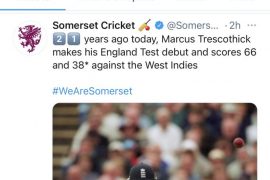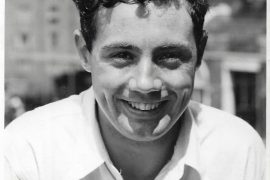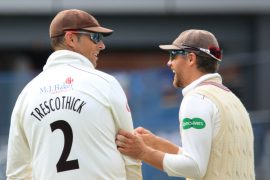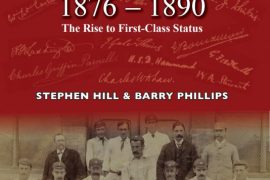
Managed by a Board of Trustees, the Somerset Cricket Museum is a charity that owns two buildings and the land on which they stand. The Museum itself is housed in a 15th century stone barn, the last remaining building of Taunton Priory, founded around 1120 and dissolved by Henry VIII in 1539.
The Priory Barn has had a variety of uses and modifications over the centuries, the most recent being as a store in a builder’s yard and before that as a farm barn. Almost derelict in the 1980s, it was classified as an ancient monument. The newly established Somerset Cricket Museum bought it in the 1980s and set about major reconstruction works to make it safe and to replace the roof. It is now Grade II* listed. Following the receipt of a major legacy in 2010 the building has been completely renovated and brought up to modern safety and efficiency standards and it is where the main cricket collections are displayed.

To move the museum forward after the Covid shutdowns the Trustees decided to update the register of items and make the collections available to the wider public. So we began the project to refresh the museum’s website and put its collection online. The key aims being:
To raise the profile of the Museum, especially for people living away from Taunton by enabling collections to be viewed online.
To create an environment where data is available for volunteers to be able to view and update (as opposed to having a single spreadsheet) and where data is secure.
To inspire people to start playing cricket within the county of Somerset
Additionally, we wanted to make it a dynamic website, so a photo gallery, news items, snippets and articles from the Somerset County Cricket club commentary team, journalists, trustees and supporters have all been included and are regularly updated. If you can contribute a story or a snippet or some insight into the history of cricket in Somerset, please do not hesitate to contact us.
As a child I would hurry downstairs every morning and devour the cricket pages of the Daily Telegraph to catch up on the previous day’s play. Who would be first to 1,000 runs (the mythical target of doing so by the end of May was always exciting); who had taken the most wickets; where were Somerset in the County Championship Table and where were the Somerset players positioned in the averages? So, my support for Somerset began – a club I am very proud to be a member of today.
As in all sport, children wait around for autographs. I vividly recall that afternoon waiting outside the players entrance in the St James Street car park (roughly where the entrance to the Stragglers Coffee shop is now) for the players to emerge and hopefully give autographs. Most keenly sought were the autographs of the visiting international tourists, the 1961 South Africans particularly touring coming to mind.
One day, as I was clearing out an old wardrobe I came across that old autograph book and decided to donate it to the Somerset Cricket Museum. Years later, during the Covid lockdown I took the decision to blog my early memories and thought that a few pictures of those old autographs would be helpful to illustrate the blog. As a result I was in contact with David Wood the Curator in an attempt to retrieve my book from the Archives.
At just about the same time, on commentary, Anthony Gibson put out a call for volunteers to help in the Museum, so, I thought, an opportunity not only to help the Museum but also to locate my autograph book. I met with David, the Curator, and as he showed me around the museum, those childhood memories came flooding back. The old printing press that was used to print the scorecards, Bill Alley’s bat with which he scored over 3,000 runs in the 1960 season, the photographs of the team I first watched. So my voluntary work began.
My first task was to catalogue 92 private albums of photographs taken over a 15 year period. I hasten to add that I only listed the contents of each album and the matches recorded, not the individual photographs but they are all in the museum for anyone to browse through.
Where to start next? Clearly, no work had been done throughout the Covid lockdown so much catching up was needed. It was also apparent that no recent, formal, data recording structure existed. So by trial and error and in conversation with the Somerset County Museum and the South West Heritage organisation, plus a comparison with the Yorkshire CCC data structure, a structure was agreed and work started, going through one of the many shelves on the Office area.
I was given a very old USB memory stick from 2011, upon which I chanced upon the register of some 1,100 assets recorded at that time. Whilst in an ‘electronic’ format, it bore no resemblance to a modern spreadsheet with every data field being recorded in a different row. In a similar format were, another 1000+ scorecard and match day programmes. Also on the memory stick were some 750 photographs of collection pieces taken when the museum was first commissioned.
So, taking stock, we had to build a new data structure in Excel format, to which we had already added many post-2011 assets; we had a 2011 register of assets, gifts and loans, scorecards and match day programmes and 750 photographs – all unlinked.
A long tedious job, but the 2011 data records were all analysed, reformatted and linked into the new spreadsheet. Similarly, the 750 photographs were linked to their original asset listings – we had the makings of a comprehensive database to move forward with.
Having all this data in Excel format was great, but what were we going to do with it long term? Clearly the answer was to put it online on a new, refreshed museum website. David put me in touch with Joe Tipler, an IT consultant, who provided support for both the museum’s interactive displays and the existing, static, website.
Between us, we came up with some ideas, many modelled on other museum websites, for example the Somerset Heritage Centre and Bristol Archives, and we started to put together a ‘Proof of Concept’ website, which incorporated the existing static pages, plus the museum collections, both the featured collections and existing museum collections.
The technical word here is taxonomy (a scheme of classification) in our case a three-level taxonomy was agreed. At the highest level (L1) we had the 16 major collections including, cricket clothing and equipment, artwork and photographic work. At the next level (L2) were, for example artwork, oil paintings, watercolours etc and finally, at Level 3 we defined Bats, Pads, Balls, Pictures, Prints etc.
We also had to cater for the featured collections. This year (2022) we will be featuring Victorian Art – a collection of miniature paintings, one-day matches (pre T20 and The 100), Hat-trick Heroes and contrasting Players Contracts (1939 & 2021).
Classification of the assets was relatively simple although it did take several passes to sort out, for example, framed, unframed, glazed, colour and black and white photographs into something simpler for display purposes.
Linking the old photographs to their asset record was also a long painstaking task. Most photos were simply recorded against the cabinet in which the piece was originally displayed M1, O3, WC1 etc so matching to records was not that straightforward but eventually this activity was completed although the diligent viewer might notice a wrong bat allocated to the wrong owner or similar!
An audit of the museum and storeroom was also undertaken against the original photographs so we are fairly sure now of what exists and where it is displayed or stored. Is the asset data collection complete? By no means, the retrospective data collection and cataloguing work will go on for some time yet but we are now in a good place.
We also felt that in addition to the existing static pages, to give the website a more modern, inclusive, approach we had to add additional features in addition to the displays and collections. As a result we have now added:
A news, articles and snippets page where we can post pieces written by journalists, trustees and cricket lovers.
A photograph gallery (that could be updated on a monthly basis)
A search facility enabling visitors to search the collections by keywords
A scorecard and programmes listing -although much more work is needed here
A ‘Links’ page, with links to all county cricket clubs and their museums/heritage centres, tweets by County Cricket Heritage Foundation and Somerset Cricket Club and all cricket clubs within Somerset.
and finally a comprehensive Help page
Guidance by Joe and assistance from the publication WordPress for Dummies, helped me design the pages and menus, leaving Joe to concentrate on the technical coding, mainly around the data imports and collection displays.
Following a Trustees meeting in February of this year (2022) acceptance of the proof of concept was given and a challenge was set to go live by the beginning of the season – a task achieved when we went live prior to the third preseason friendly v Warwickshire.
Was the project a success? I can only judge by (a) the feedback that we have received and (b) the number and reach of visitors using the facility.
‘It looks modern and is easy to navigate – really good work. Love Anthony’s article! ‘ – Annie Chave editor of County Cricket Matters
‘This is brilliant. Congratulations on some great work! Will try and get something out soon 👍’ – Ben Warren SCCC Digital Media Executive
Some feedback from the photo artist who let me have copies of the Heather Knight / Katherine Brunt prints
‘I’m so chuffed that my pictures of Heather Knight and Katherine Brunt are in your collection. I loved watching the video of the museum. It looks absolutely beautiful and it’s wonderful that the building itself has so much history to it. To think my work is in the same collection as Viv’s cap – gulp!’
‘Great work on the website and getting the museum experience out there – it’s a fantastic place 🤗 depending on what kind of stuff and information you may be after I may be able to assist.’
Michelle Brooks who used to be Secretary to the SCCC Chief Exec prior to Covid
‘I’m not sure whether you intended to send this email to more than just me, but I had a look at your website and it looks great. Clear and easy to use with the drop-down menus, an excellent range of content. I’m sure we can take inspiration from this. There’s nothing wrong with a function over form approach!
Well done and best wishes’
Robert Curphey Curator at Lords Cricket Museum.
Over the first three weeks of April we have had over 3,350 page views from 22 different countries including Australia, New Zealand, the USA, Canada, Europe and even China!
But we are not going to stop there. Our next tasks are:
Increase the number of followers on our rebuilt Facebook and Instagram pages, an activity being undertaken by Matt Hallows. Secondly add further features to the website such as:
Allow automatic retrieval of actual scorecard data. It could be a life’s work scanning the old scorecards but that data already exists online
Add some audio pieces to the site, firstly against the Featured Collections, then a short bio of every SCCC captain (a project being undertaken by Matthew Aung)
Add more video but the copyright laws may well prohibit this activity
Add more articles (possibly at Club Level) on cricket within the County of Somerset
Set up an online bookshop
What can readers of Somerset North Blog do assist us? Firstly become a member and/or make a donation to the museum (via the Home Page),
Secondly subscribe to the museum site to receive regular updates
Thirdly, commit some time so that the Museum can be open on more than just match days.
Fourthy, write an article or a few line blog giving some insights into the history of cricket in Somerset, and.
Finally donate any cricket memorabilia that you might have to the Museum (with the exception of Wisden books and Cricketer magazines – we have every addition from the year dot!)
If you would like to hear Mike talk to Charlie Taylor on the recent BBC Somerset Cricket Show click here


















